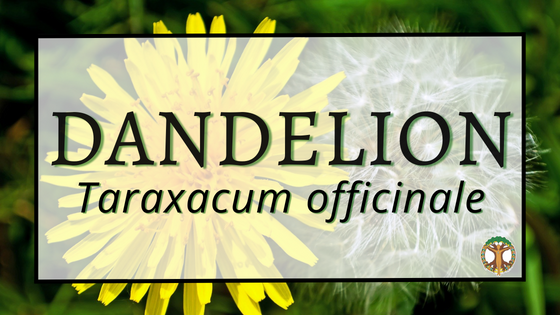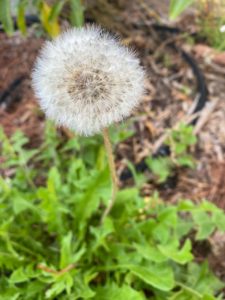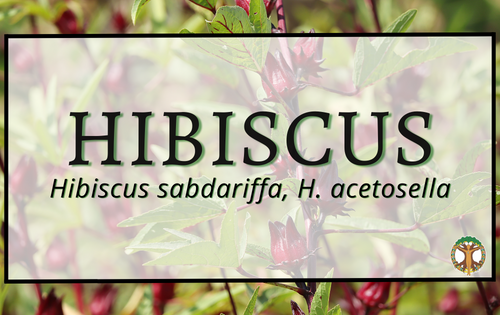
Dandelion
Latin Name, Family & Common + Folk Names
Latin Name: Taraxacum officinale
Family: Asteraceae
Common & Folklore Names: Dandelion, Lion’s Tooth, Blowball, Monk’s Head, Priest’s Crown, Dent-de-Lion (French for tooth of the lion), Pissenlit (French for piss the bed)
Botanical Information
Habitat: T. officinale grows wild on six of the seven continents. Want to guess which one is not sprouting this golden source of sustenance. One hint…its frozen tundra makes growing anything herbal quite unlikely.

However, it’s widespread global footprint, doesn’t mean it grows well in all climates and environments. For instance, it’s rare to see one in growing wild here in Central Florida. It becomes more likely in the Gainesville/Ocala region, and more common as you head north.
It prefers undisturbed areas and wide open spaces. Think pastures, the sides of road ways, and, of course, lawns.
Propagation: Dandelions are, perhaps, most recognized by their seed heads. Those beautiful puffs that children (and many many adults) can’t resist pulling from the ground to blow into the wind. Those wishes we’re all blowing into the air, though, are also carrying clones of the parent plant. Each seed head creates anywhere from 54 to 176 seeds, giving the dandelion multitudes of opportunities to clone itself with every gust. Therefore, no pollinators are needed. Just one seed that roots into the ground and thrives. And Dandelion will take care of the rest.
Description: Leaves are sharply-toothed that grow directly from the ground in rosettes. The flowers are bright yellow and inflorescent. The root is perennial and tapering, simple and branched, and in good soil will attain a length of a foot or more and grow to be 1/2 to an inch in diameter.
History and Background
The history of the dandelion runs parallel to the history of human civilization. Wherever there is open space, they move in and, for lack of better words, take over. Dandelion has traveled and spread alongside the spread of colonialists, being brought along as an easy to cultivate and nutritious food source. Some believe the seeds traveled with the hay as colonists made their way across the globe, others believe they were intentionally carried to create new crops in lands where food supply was unknown.
There are references to the medicinal uses in written history as far back as the 11th century by Arabic physicians, and the 13th century by Welsch physicians. We know it goes back further due to Greek mythology, in which Hecate—goddess of the underworld—is said to have fed dandelions to Theseus for 30 days to give him the strength to defeat the Minotaur.
So, if this plant has such a history as being a staple in diets and medicinal use, how then did it become classified as a weed? And not only is it considered a pest by many, it’s often the quintessential representation for all weeds. Next time you visit your hardware or home store, take a look at the weed killers. Notice a certain plant ally posted on the labels?
In 17th century England, Western culture sees the “rise of the lawn.” Royals had had their gardens for centuries, but now we see the aristocracy begin to demonstrate their affluence for all to see that they didn’t need to grow their own food. They were wealthy enough to purchase it from outside sources. Therefore, following in the royal footsteps they began to use their vast manicured lawns and gardens as a symbol for status. Anything wild went out by the wayside and trickle this mentality down through history and we still, to this day, see a preference to manicured laws kept “weed”-free.
Herbalism and Uses
Parts Used: More often, the leaves and roots, both fresh and dried, are what is used, but the flower is edible.
Uses: The roots can be eaten much like any root vegetable. These are best picked in the Fall when the leaves have browned and they are grown to full-size. They can be dried and roasted to make a tea that is a diuretic and makes for an excellent caffeine-free coffee substitute. They can be used to make tinctures. Alcohol will extract the medicinal qualities and vinegar will pull the minerals—making it a nutritious addition to daily salad dressings. Overall, the root is an aide for poor digestion, liver function, prebiotics, and osteoarthritis.
The leaves are bitter when fresh, increasing in bitterness after the blooming. This bitter property increases saliva which helps break down starches and also proteins, increases bile which aids in fat digestion, and stimulates natural peristalsis. The leaves, too, are a diuretic. Hence the French name piss en lit which translates to “piss the bed” in English. Use them fresh in a salad, cook them with other vegetable or greens, or cook them any way you’d cook other greens. Medicinally, the fresh and dried leaves can be made into a tea, tincture, or vinegar extract.
The flowers are high in lutein, a constituent known to support eye health. The flower syrup that comes from breaking the stalk tastes nutty and like vanilla, and is reputed to be a mood lifter. You can cook the flowers and make fried dandelion fritters, or eat the petals fresh in a salad. Jelly and wine are popular uses for the flowers, as is baking them into cookies or breads. Harvesting is best done in early spring, in the middle of the morning on a hot day, and processed right away.
Contraindications: There are no known contraindications, however, if one has an allergy to the Asteraceae family, mild reactions can result when using Dandelion.
Cautions: As with any wild foraging, you want to be mindful of where you’re picking. Avoid places close to roads and anywhere pesticides are used. With Dandelion roots growing as deep as they do, there’s extra reason to ensure that you’re not foraging in a place that’s used pesticides within the previous 5 years or had any kind of toxic waste ever.
Key Constituents: Sesquiterpene lactones Triterpenes, Polysaccharides
Leaf Constituents: Coumarins, Carotenoids, Minerals
Root Constituents: Taraxacoside, Phenolic acids, Mineralls
Actions: Diuretic, Detoxifying, Bitter
Recipe:
Contributed By Shay DeGrandis, Herbalism Instructor, Florida School of Holistic Living
4-6 cloves of garlic (depending on clove size and how garlicky you want the flavor)
2-3 Tbsp Olive oil
1/3 cup chopped onions
1/4 cup dried fruit, chopped (dates, raisins, cranberries are best)
1-4 anchovy filets (optional for vegan)
1 large bunch of fresh, Dandelion
your preferred green: kale, Swiss chard, mustard, turnip, collards, spinach, Bidens or Chaya or (after boiling first). Cooking times will vary with each, depending on type)
2-4 Tbsp of vinegar (see note below)
Salt and black pepper to taste
Optional additions to sprinkle on top: Crushed red pepper, hemp seeds, moringa powder, kelp, grated Parmesan/Pecorino/Romano cheese (or nutritional yeast for vegan)
- Peel and mince garlic. Put aside and let garlic sit while preparing other ingredients.
- Wash and chop greens. Make sure to get all dirt off to avoid grittiness. Leave some water on the leaves so they steam and wilt while cooking.
- Chop onions and dried fruit.
- Heat large sauté pan. Add oil once warmed.
- Add onions to pan and cook, stirring regularly, until it begins to turn translucent, about 2 minutes.
- Add fruit to pan. Cook until it begins to soften.
- If using anchovy, place filets in pan and stir around until they melt into mixture.
- Add garlic to pan. Stir into mixture until it becomes fragrant, about 1-2 minutes. Do not overcook.
- Add leafy greens. Stir to coat in mixture. Stir occasionally to ensure all leaves begin to wilt.
- Continue to cook until leaves are wilted to your desired texture. If the leaves are tougher, you can add a splash of water or stock to help with wilting — do this early enough so the liquid has time to evaporate during cooking.
- Sprinkle with vinegar: place just enough vinegar onto the leaves to get them wet but avoid drowning them.
- Add salt and pepper to taste.
- Remove from heat and sprinkle with any additional ingredients.
NOTE: You can use any type of vinegar you prefer and will get a different flavor profile from each: red wine or apple cider will make it tarter; balsamic, an herbal oxymel or a dash of honey in the mix adds more sweetness; Fire Cider will give it a deeper flavor and some spiciness. Experiment!
References:
Chevallier, Andrew. “Taraxacum Officinale.” Essay. In Encyclopedia of Herbal Medicine 1, 1:141–41. New York, NY: DK/Penguin Random House, 2016.
DeGrandis, Shay. Plant Profile: Dandelion with Shay DeGrandis. YouTube, 2022.
Grieve, M. “Dandelion.” In A Modern Herbal: The Medicinal, Culinary, Cosmetic and Economic Properties, Cultivation and Folk-Lore of Herbs, Grasses, Fungi, Shrubs & Trees with All Their Modern Scientific Uses, 249–55. New York, NY: Dover Publications, 1982.
Hanna, Gabbie. Poem. In Dandelion, 104–5. New York, NY: Simon & Schuster, 2020.
The History Guy. Dandelions and Civilization: A Forgotten History. YouTube, 2019. https://www.youtube.com/watch?v=xyePMeGE3CI.





